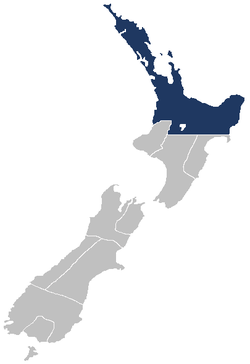Auckland Provincial Council
| Auckland Province | |
|---|---|
| Provinces of New Zealand | |
 Auckland Province within New Zealand |
|
| Country | New Zealand |
| Island | North Island |
| Established | 1853 |
| Abolished | 1876 |
| Named for | Baron Auckland |
| Seat | Auckland |
Coordinates: 35°54′S 174°20′E / 35.900°S 174.333°E The Auckland Province was a province of New Zealand from 1853 until the abolition of provincial government in 1876.
The province covered roughly half of the North Island of New Zealand. It was the largest of the six initial provinces, both by area and population. The southern boundary was mostly along the 39th latitude, which was an arbitrary line, as the country's interior was little known by Europeans. It was not subdivided during its existence; the Taranaki Province (originally named New Plymouth Province) was the other one that kept its boundaries.
The six original provinces were established in 1853. At that time, about 30,000 Europeans were living in New Zealand, and a third of them were based in the Auckland Province. An estimated 70% of the Māori population was within the Auckland Province. Although the population of Otago Province (triggered by the Central Otago Gold Rush) and then also the Canterbury Region surpassed Auckland's, the northernmost area of the country became most populous again by 1901.
The provincial system was abolished in 1876. Auckland Province was from then used as an administrative district by the Department of Lands and Survey, but the area was later subdivided into the North Auckland, South Auckland, and Gisborne land districts. The 39th latitude was subsequently replaced by boundaries that took landforms into account, and as a consequence, parts of the former Auckland Province are now in the Wellington and Hawke's Bay land districts, and part of the former Wellington Province is in the South Auckland Land District.
...
Wikipedia
